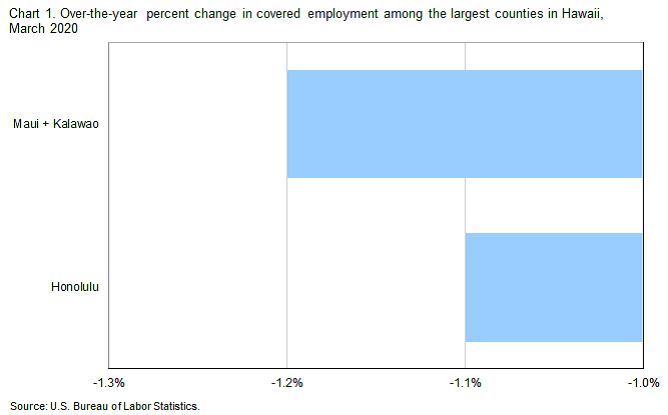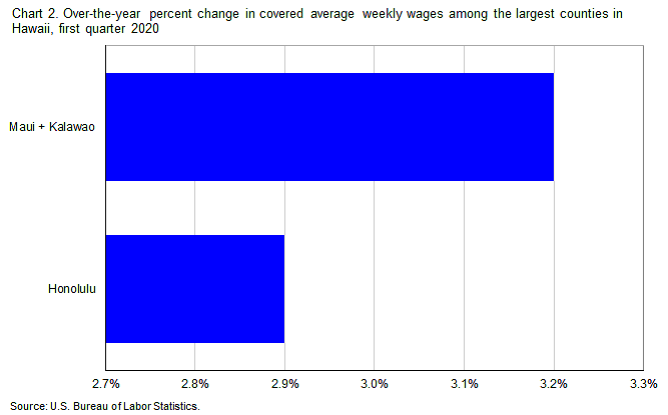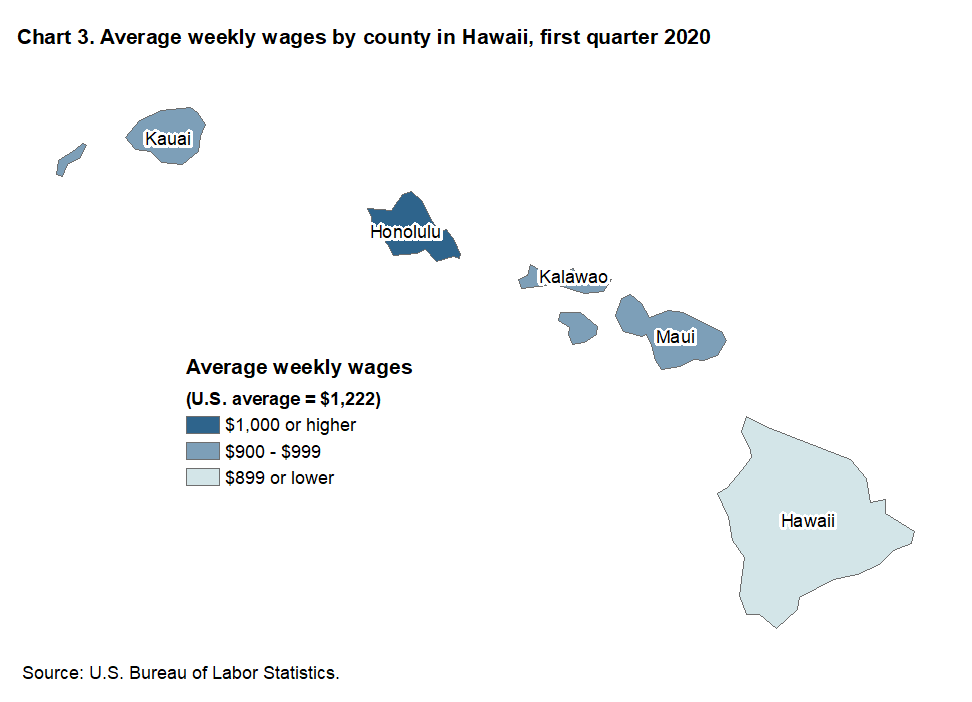
For Release: Tuesday, November 10, 2020
20-2109-SAN
| Technical information: | (415) 625-2270 | BLSinfoSF@bls.gov | www.bls.gov/regions/west |
| Media contact: | (415) 625-2270 |
County Employment and Wages in Hawaii – First Quarter 2020
Employment fell in each of Hawaii’s two large counties from March 2019 to March 2020, the U.S. Bureau of Labor Statistics reported today. (Large counties are those with annual average employment levels of 75,000 or more in 2019.) Assistant Commissioner for Regional Operations Richard Holden noted that Maui + Kalawao County and Honolulu County had over-the-year employment declines of 1.2 percent and 1.1 percent, respectively. (See chart 1 and table 1.)
Employment increased 0.4 percent over the year with 202 of the 357 largest U.S. counties reporting increases. St. Johns, FL, had the largest percentage increase in the country, up 3.7 percent over the year. Ector, TX, had the largest over-the-year percentage decrease in employment with a loss of 5.5 percent.
Between the two largest counties in Hawaii, employment was higher in Honolulu County (467,100) in March 2020. Within Honolulu County’s private industry, accommodation and food services accounted for the largest employment. Together, Hawaii’s two large counties accounted for 83.5 percent of total employment within the state. Nationwide, the 357 largest counties made up 73.7 percent of total U.S. employment.
Employment and wage levels (but not over-the-year changes) are also available for Hawaii and Kauai, the two counties in Hawaii with employment below 75,000. Both of these smaller counties had average weekly wages below the national average in the first quarter of 2020. (See table 2.)
Large county wage changes
Hawaii’s two large counties reported average weekly wage gains that were below the national rate of 3.3 percent. (See chart 2.) Maui + Kalawao County had the larger gain (+3.2 percent), followed by Honolulu (+2.9 percent).
Among the 357 largest counties in the United States, 335 had over-the-year wage increases. McLean, IL, had the largest percentage wage increase (+13.3 percent). Twenty large counties had wage declines during the period. Peoria, IL, had the largest over-the-year percentage decrease (-12.8 percent).
Large county average weekly wages
The average weekly wage in Honolulu County ($1,033, 159th) placed in the top half of the national ranking. Average weekly wages in Maui + Kalawao ($927, 287th) placed in the bottom half of the national ranking. Nationally, the average weekly wage was $1,222.
Among the largest U.S. counties, 92 reported average weekly wages above the U.S. average in the first quarter of 2020. New York, NY, had the highest average weekly wage at $3,270. Average weekly wages were below the national average in 265 counties. At $666 a week, Cameron, TX, had the lowest average weekly wage.
Additional statistics and other information
QCEW data for states have been included in this release in table 3. For additional information about quarterly employment and wages data, please read the Technical Note or visit www.bls.gov/cew.
Employment and Wages Annual Averages Online features comprehensive information by detailed industry on establishments, employment, and wages for the nation and all states. The 2018 edition of this publication was published in September 2019. Tables and additional content from the 2018 edition of Employment and Wages Annual Averages Online are available at www.bls.gov/cew/publications/employment-and-wages-annual-averages/2018/home.htm. The 2019 edition of Employment and Wages Annual Averages Online will be available in September 2020.
The County Employment and Wages release for second quarter 2020 is scheduled to be released on Wednesday, November 18, 2020. The County Employment and Wages full data update for second quarter 2020 is scheduled to be released on Wednesday, December 2, 2020.
QCEW Data and Response Impacted by the COVID-19 Pandemic
Beginning with this release of first quarter 2020 data, the Quarterly Census of Employment and Wages (QCEW) program will publish response rate tables for establishments, employment, and total quarterly wages. Tables for the first quarter of 2020 are available at www.bls.gov/covid19/county-employment-and-wages-covid-19-impact-first-quarter-2020.htm. For more information about the effects of the COVID-19 pandemic on QCEW data, please visit www.bls.gov/covid19/effects-of-covid-19-pandemic-on-county-employment-and-wages-data.htm
Technical Note
Average weekly wage data by county are compiled under the Quarterly Census of Employment and Wages (QCEW) program, also known as the ES-202 program. The data are derived from summaries of employment and total pay of workers covered by state and federal unemployment insurance (UI) legislation and provided by State Workforce Agencies (SWAs). The average weekly wage values are calculated by dividing quarterly total wages by the average of the three monthly employment levels of those covered by UI programs. The result is then divided by 13, the number of weeks in a quarter. It is to be noted, therefore, that over-the-year wage changes for geographic areas may reflect shifts in the composition of employment by industry, occupation, and such other factors as hours of work. Thus, wages may vary among counties, metropolitan areas, or states for reasons other than changes in the average wage level. Data for all states, Metropolitan Statistical Areas (MSAs), counties, and the nation are available on the BLS web site at www.bls.gov/cew/. However, data in QCEW press releases have been revised and may not match the data contained on the Bureau’s web site.
QCEW data are not designed as a time series. QCEW data are simply the sums of individual establishment records reflecting the number of establishments that exist in a county or industry at a point in time. Establishments can move in or out of a county or industry for a number of reasons–some reflecting economic events, others reflecting administrative changes.
The preliminary QCEW data presented in this release may differ from data released by the individual states as well as from the data presented on the BLS Web site. These potential differences result from the states’ continuing receipt, review and editing of UI data over time. On the other hand, differences between data in this release and the data found on the BLS web site are the result of adjustments made to improve over-the-year comparisons. Specifically, these adjustments account for administrative (noneconomic) changes such as a correction to a previously reported location or industry classification. Adjusting for these administrative changes allows users to more accurately assess changes of an economic nature (such as a firm moving from one county to another or changing its primary economic activity) over a 12-month period. Currently, adjusted data are available only from BLS press releases.
Information in this release will be made available to individuals with sensory impairments upon request. Voice phone: (202) 691-5200; Federal Relay Service: (800) 877-8339.
| Table 1. Covered employment and wages in the United States and the two largest counties in Hawaii, first quarter 2020 | ||||||||
|---|---|---|---|---|---|---|---|---|
| Area | Establishments, first quarter 2020 (thousands) | Employment | Average weekly wage (1) | |||||
| March 2020 (thousands) | Percent change, March 2019-20 (2) | National ranking by percent change (3) | First quarter 2020 | National ranking by level (3) | Percent change, first quarter 2019-20 (2) | National ranking by percent change (3) | ||
| - Continued | ||||||||
United States (4) | 10,447.2 | 147,088.9 | 0.4 | -- | 1222 | -- | 3.3 | -- |
Hawaii | 45.4 | 655.5 | -1.0 | -- | 1033 | 27 | 3 | 29 |
Honolulu | 27.5 | 467.1 | -1.1 | 300 | 1083 | 159 | 2.9 | 187 |
Maui + Kalawao | 6.8 | 80.2 | -1.2 | 308 | 927 | 287 | 3.2 | 165 |
Footnotes: | ||||||||
Note: Data are preliminary. Covered employment and wages includes workers covered by Unemployment Insurance (UI) and Unemployment Compensation for Federal Employees (UCFE) programs. | ||||||||
Footnotes:
(1) Average weekly wages were calculated using unrounded data.
(2) Percent changes were computed from quarterly employment and pay data adjusted for noneconomic county reclassifications.
(3) Ranking does not include data for Puerto Rico or the Virgin Islands.
(4) Totals for the United States do not include data for Puerto Rico or the Virgin Islands.
Note: Data are preliminary. Covered employment and wages includes workers covered by Unemployment Insurance (UI) and Unemployment Compensation for Federal Employees (UCFE) programs.
| Table 2. Covered employment and wages in the United States and all counties in Hawaii, first quarter 2020(1) | ||
|---|---|---|
| Area | Employment March 2020 | Average Weekly Wage(2) |
| - Continued | ||
United States(1) | 147,088,945 | $1,222 |
Hawaii | 655,471 | 1,033 |
Hawaii | 72,450 | 872 |
Honolulu | 467,098 | 1,083 |
Kauai | 33,638 | 912 |
Maui + Kalawao | 80,217 | 927 |
Footnotes | ||
Note: Includes workers covered by Unemployment Insurance (UI) and Unemployment Compensation for Federal Employees (UCFE) programs. Data are preliminary. | ||
Footnotes
(1) Totals for the United States do not include data for Puerto Rico or the Virgin Islands.
(2) Average weekly wages were calculated using unrounded data.
Note: Includes workers covered by Unemployment Insurance (UI) and Unemployment Compensation for Federal Employees (UCFE) programs. Data are preliminary.
| Table 3. Covered employment and wages by state, first quarter 2020 | |||||||
|---|---|---|---|---|---|---|---|
| State | Establishments, first quarter 2020 (thousands) | Employment | Average weekly wage (1) | ||||
| March 2020 (thousands) | Percent change, March 2019-20 | First quarter 2020 | National ranking by level | Percent change, first quarter 2019-20 | National ranking by percent change | ||
| - Continued | |||||||
United States (2) | 10,447.2 | 147,088.9 | 0.4 | $1,222 | -- | 3.3 | -- |
Alabama | 132.6 | 1,983.8 | 0.3 | 974 | 36 | 3.2 | 23 |
Alaska | 22.6 | 312.8 | -0.1 | 1,130 | 19 | 2.1 | 44 |
Arizona | 170.4 | 2,957.2 | 1.9 | 1,098 | 22 | 4.4 | 1 |
Arkansas | 93.6 | 1,220.5 | 0.2 | 922 | 45 | 3.0 | 29 |
California | 1,631.1 | 17,570.5 | 0.8 | 1,459 | 5 | 4.2 | 3 |
Colorado | 214.5 | 2,725.2 | 1.2 | 1,284 | 9 | 4.3 | 2 |
Connecticut | 124.1 | 1,639.4 | -0.7 | 1,510 | 4 | 1.5 | 48 |
Delaware | 34.6 | 443.7 | -0.3 | 1,251 | 11 | 1.7 | 45 |
District of Columbia | 42.3 | 778.1 | 0.6 | 1,994 | 1 | 3.8 | 14 |
Florida | 740.5 | 8,975.1 | 0.8 | 1,051 | 25 | 3.6 | 18 |
Georgia | 301.5 | 4,522.2 | 0.9 | 1,159 | 17 | 3.4 | 19 |
Hawaii | 45.4 | 655.5 | -1.0 | 1,033 | 27 | 3.0 | 29 |
Idaho | 66.8 | 755.2 | 3.1 | 864 | 50 | 4.2 | 3 |
Illinois | 381.5 | 5,872.9 | -0.7 | 1,302 | 8 | 2.3 | 41 |
Indiana | 171.1 | 3,028.5 | -1.0 | 994 | 33 | 3.2 | 23 |
Iowa | 104.8 | 1,523.4 | -0.2 | 978 | 35 | 3.7 | 16 |
Kansas | 89.8 | 1,383.3 | 0.2 | 969 | 37 | 3.2 | 23 |
Kentucky | 124.0 | 1,884.9 | 0.1 | 943 | 43 | 2.5 | 38 |
Louisiana | 137.4 | 1,897.0 | -1.3 | 969 | 37 | 1.7 | 45 |
Maine | 53.9 | 601.0 | 0.1 | 955 | 40 | 4.0 | 11 |
Maryland | 175.7 | 2,661.5 | -0.4 | 1,277 | 10 | 4.1 | 8 |
Massachusetts | 263.3 | 3,565.1 | -0.2 | 1,605 | 3 | 3.0 | 29 |
Michigan | 267.0 | 4,281.4 | -0.6 | 1,103 | 20 | 2.3 | 41 |
Minnesota | 183.9 | 2,838.2 | -0.1 | 1,235 | 12 | 2.7 | 35 |
Mississippi | 73.9 | 1,128.1 | -0.2 | 801 | 51 | 2.8 | 34 |
Missouri | 214.8 | 2,795.7 | 0.3 | 1,016 | 31 | 3.0 | 29 |
Montana | 50.6 | 465.2 | 1.5 | 869 | 49 | 3.1 | 27 |
Nebraska | 72.3 | 972.4 | 0.8 | 956 | 39 | 4.1 | 8 |
Nevada | 86.1 | 1,410.8 | 1.3 | 1,033 | 27 | 4.2 | 3 |
New Hampshire | 54.3 | 657.0 | 0.2 | 1,194 | 15 | 3.3 | 20 |
New Jersey | 285.8 | 4,052.7 | 0.4 | 1,455 | 6 | 3.9 | 13 |
New Mexico | 64.0 | 835.6 | 0.9 | 923 | 44 | 3.7 | 16 |
New York | 657.2 | 9,415.7 | -0.3 | 1,693 | 2 | 3.3 | 20 |
North Carolina | 296.0 | 4,501.1 | 0.9 | 1,094 | 23 | 4.1 | 8 |
North Dakota | 32.2 | 414.3 | 0.0 | 1,046 | 26 | 2.4 | 39 |
Ohio | 304.4 | 5,349.6 | -0.3 | 1,063 | 24 | 2.9 | 33 |
Oklahoma | 112.8 | 1,598.0 | -1.3 | 949 | 42 | -0.5 | 51 |
Oregon | 162.4 | 1,938.9 | 0.7 | 1,103 | 20 | 4.2 | 3 |
Pennsylvania | 363.5 | 5,851.3 | 0.0 | 1,177 | 16 | 2.7 | 35 |
Rhode Island | 39.5 | 473.9 | -0.2 | 1,132 | 18 | 2.7 | 35 |
South Carolina | 142.7 | 2,112.8 | 0.1 | 922 | 45 | 2.2 | 43 |
South Dakota | 34.7 | 420.6 | 0.4 | 901 | 48 | 4.2 | 3 |
Tennessee | 171.2 | 3,033.5 | 1.0 | 1,027 | 29 | 3.1 | 27 |
Texas | 725.7 | 12,626.2 | 1.2 | 1,232 | 14 | 2.4 | 39 |
Utah | 109.8 | 1,526.8 | 1.8 | 1,026 | 30 | 3.2 | 23 |
Vermont | 26.1 | 303.9 | -1.8 | 980 | 34 | 3.3 | 20 |
Virginia | 282.9 | 3,921.0 | 0.6 | 1,233 | 13 | 4.0 | 11 |
Washington | 255.6 | 3,427.3 | 1.7 | 1,414 | 7 | 3.8 | 14 |
West Virginia | 51.2 | 674.9 | -1.8 | 904 | 47 | 0.9 | 49 |
Wisconsin | 178.2 | 2,836.5 | -0.2 | 1,008 | 32 | 1.7 | 45 |
Wyoming | 27.2 | 268.5 | -0.5 | 955 | 40 | 0.6 | 50 |
Puerto Rico | 47.5 | 886.4 | 1.0 | 551 | (3) | 0.0 | (3) |
Virgin Islands | 3.3 | 40.1 | 5.7 | 1,046 | (3) | 6.3 | (3) |
Footnotes: | |||||||
Note: Data are preliminary. Covered employment and wages includes workers covered by Unemployment Insurance (UI) and Unemployment Compensation for Federal Employees (UCFE) programs. | |||||||
Footnotes:
(1) Average weekly wages were calculated using unrounded data.
(2) Totals for the United States do not include data for Puerto Rico or the Virgin Islands.
(3) Data not included in the national ranking.
Note: Data are preliminary. Covered employment and wages includes workers covered by Unemployment Insurance (UI) and Unemployment Compensation for Federal Employees (UCFE) programs.


